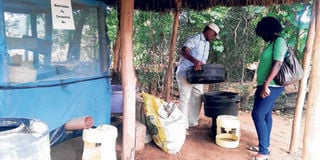Insect meals for poultry and fish in the offing

Gideon Amboga, the chief operations officer at Baobab Trust, shows how the larvae is harvested using a composting bin. PHOTO | BOZO JENJE | NATION MEDIA GROUP
What you need to know:
- It is this larvae that is fed to poultry for faster growth and to increase production.
- “The protein from insects is natural and has no chemicals. It has no side effects. It is also easily available and can be produced in large quantities and cheaply,”
- Lead researcher Prof Monicah Ayieko from Jaramogi Oginga Odinga University of Science and Technology says the objective of the project is to transfer the flies to the farmers.
All of us generate tonnes of kitchen waste each month, which sometimes we use in our vegetable gardens as manure.
This is highly recommended, but you can now do more with that kitchen waste that some of us burn.
Scientists have developed a way to make nutritious fish and poultry feeds from the waste.
The innovation involves putting the waste in a special plastic container that has black soldier flies that lay eggs.
“The larvae hatch from the eggs in about 100 hours. They then feed on the waste for 14 to 20 days before they later turn into pupae,” explains Dr Rene Haller, the director of Baobab Trust and one of the researchers behind the project dubbed Green Insect.
A single fly hatches between 500 and 1,200 eggs at once. A gram of the eggs produces 2.4kg of larvae with 42 per cent protein, 35 per cent fat and other minerals that include calcium, vitamins and amino acids.
It is this larvae that is fed to poultry for faster growth and to increase production.
“If you are a keen observer, indigenous chickens hunt for larvae from compost pits. This diet does not affect the quality and taste of the meat and eggs products. We are trying to fill this gap because most farmers these days keep their poultry under the intensive system.”
The container has a pipe through which the farmer harvests the larvae. “They crawl from the container through a pipe and into a bucket. There they are left to turn into inactive pupae, which is then dried and crushed into powder that is feed to the fish. The larvae, on the other hand, is directly fed to chicken.”
Dr Haller noted that trials are ongoing to establish the actual rations of larvae farmers can feed their poultry but for fish, 1.8kg of pupae produces a kilo of fish.
NO SIDE EFFECTS
“The protein from insects is natural and has no chemicals. It has no side effects. It is also easily available and can be produced in large quantities and cheaply,” he says adding that fish fed on the larvae attains 350g in six months. “We are looking at the future where farmers will substitute oil and natural cereal feeds with sufficient proteins from insects.”
Using the larvae feeds will enable farmers to keep poultry, fish and grow a variety of vegetables.
“On the farm, the larvae can also be useful for bio-conversion of environmental wastes to be used as manure.”
Lead researcher Prof Monicah Ayieko from Jaramogi Oginga Odinga University of Science and Technology says the objective of the project is to transfer the flies to the farmers.
“The farmers will be able to rear them in large quantities without the insects escaping to the community.”
She notes that in the US and South Africa, farmers rear the insects in large quantities to develop fish feeds with high protein content.
“Once we establish a colony and the flies can be controlled at farm level, harvested, dried and be fed to fish or poultry, we will transfer the technology to farmers,” she says.
“We are working to reduce the oil content in the larvae that has lots of fat and increase protein levels to about 60 per cent. From 2.5kg of waste of vegetable materials, about 2.5kg of larvae can be harvested. But still research is ongoing to get exact numbers.”
According to Prof Ayieko, farmers will need initial investment in infrastructure that they will use to raise the flies and generate garbage.
It is expected that poultry and fish farmers will cut their costs by up to 50 per cent through the technology.
“With a higher colony, the garbage will not emit a lot of stench. Hydrogen will be reduced to make protein and make the environment clean. After the larvae eats the garbage, clean manure is generated for the farmers,” she says, adding that the system can be used for garbage management in estates.




